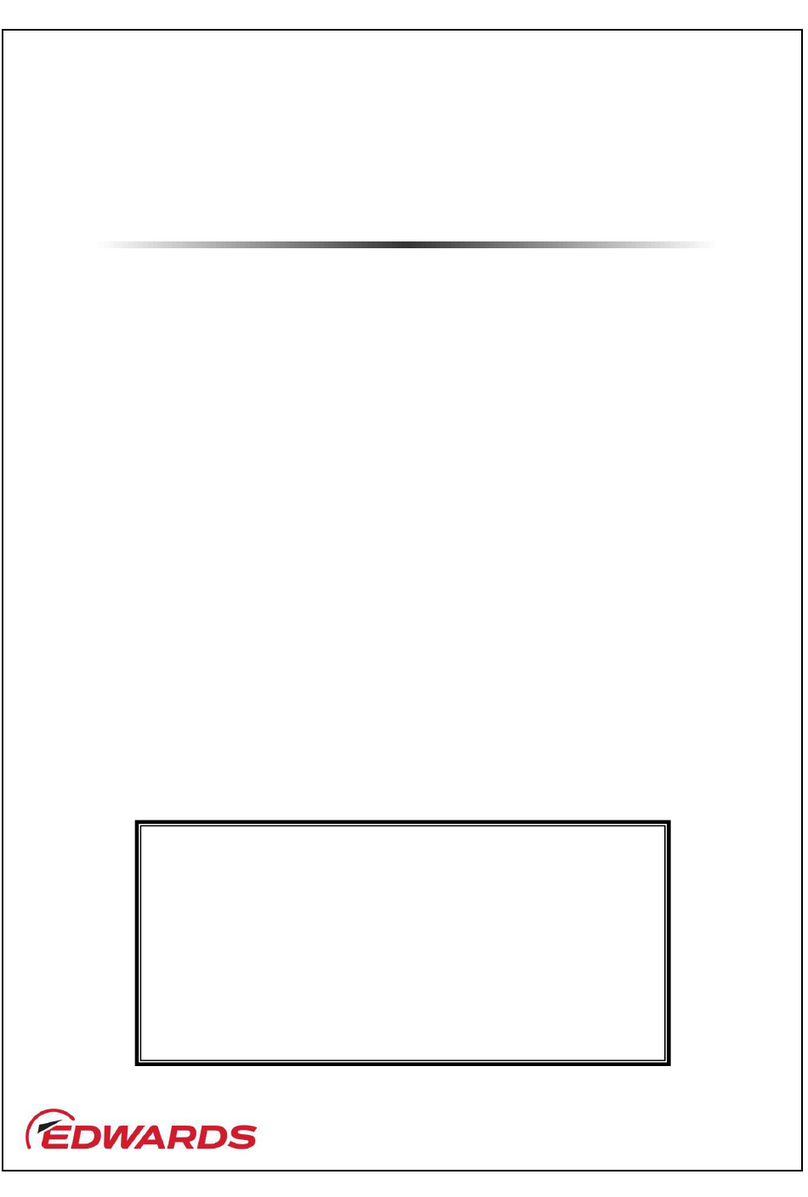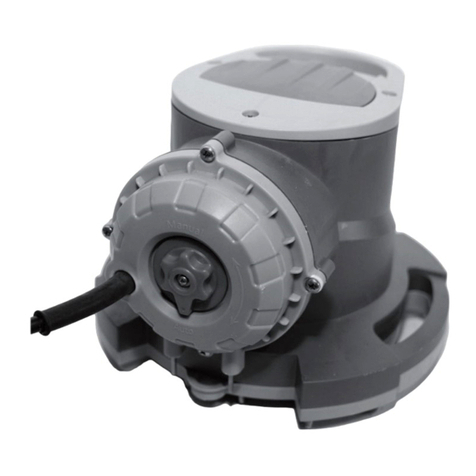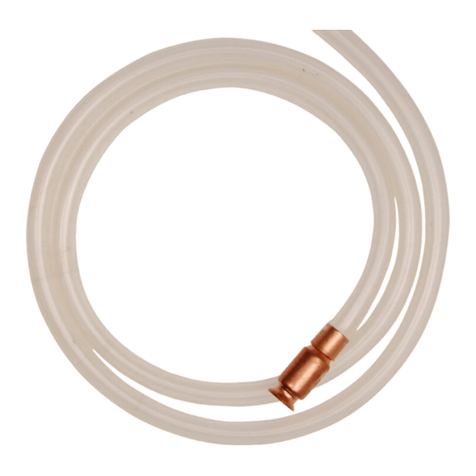Roper Pump Company 5600 Series User manual

07/31/2003
INSTALLATION, OPERATION
AND MAINTENANCE MANUAL FOR ROPER®
5600 SERIES TYPE 1
PUMPS:
5638
5658
Roper Pump Company
PO Box 269
Commerce, Georgia 30529
USA
Telephone: (706) 335-5551
TeleFAX: (706) 335-5490
Email: [email protected]
Web: www.roperpumps.com
2003 Roper Pump Company
PART NO. G12-405


Section 1.0
TABLE OF CONTENTS
Section Page
1.1 Nameplate Data ………………………………………………………… 1 - 1
1.2 Maximum Pump Ratings..…...………………………………………... 1 - 2
Page 1 – i


1.1 NAMEPLATE DATA
Roper Pump Company identifies each pump
manufactured by a metal nameplate
attached to the pump. This nameplate
describes the pump as built at the factory.
Copy the nameplate data from your pump in
the area provided below. Use this for ready
reference when ordering repair parts or when
consulting with Roper Pump Company or an
authorized distributor about this pump.
FIGURE NUMBER:
SPEC NUMBER:
TYPE:
SERIAL NUMBER:
PUMP NOMENCLATURE
Example: 5658 HFL SPEC XXX
TYPE 1 SERIAL NO. ZZZ
1. The FIGURE number consists of a
seven digit number.
• The first digit (5) indicates the series.
• The second digit (6) indicates shaft
sealing.
6 −Packing
• The third and fourth digits (58) indicate
the approximate theoretical displace-
ment in US gallons per 100 revolutions.
Gallons/100 Rev. [Liters/100 Rev.]
38 [143.8]
58 [219.6]
• The letter (H) indicates the pump
head arrangement.
H Pump with inboard bushing
• The letter (F) indicates port style.
No letter −Pump with threaded ports
F −Pump with ROPER®standard
flange ports
• The letter (L) indicates shaft position.
No letter −High Drive
L −Low Drive
Example:
5658*HFL SPEC XXX TY 1 S/N XXX
56 58 * H F L
Shaft position
Port style
Pump head arrangement
Motor mounted unit *
Theoretical displacement
Shaft Sealing
Port arrangement
* The letter (M) may be used in this space indicating the pump is mounted with motor.
The letter (E) may be used in this space indicating the pump is mounted on a base
with or without engine.
Page 1 – 1

As stated in the explanation of the pump
nomenclature, all characters may not
appear on every pump nameplate.
NOTE: The preceding description of the
figure number is to assist in identifying your
ROPER®5600 series pump only. DO NOT
attempt to derive any ratings or
performance from the figure number. DO
NOT use the explanation of the figure
number to construct your own pump. Not all
combinations are possible. For assistance
in pump selection, it is recommended that
you consult Roper Pump Company or an
authorized distributor.
2. Occasionally, special pumps or
configurations are required which are
unique for a particular application.
These modifications are clarified by a
SPECification number. Identification of
any items different than a standard
pump can be made by consulting Roper
Pump Company or an authorized
distributor.
3. The TYPE number is a number used by
Roper Pump Company for in-house
identification of construction and
hydraulics. Always include the type
number in any references to the pump.
4. The SERIAL number is a unique
number assigned to each pump built by
Roper Pump Company.
In any communication concerning this
pump, always by sure to include the Figure,
Spec, Type, and Serial numbers so proper
identification of the pump can be assured.
1.2 MAXIMUM PUMP
RATINGS
The maximum pressure and speed limits for
this pump SERIES are shown below.
The maximum rating of a pump with a
SPEC number may be lower depending on
the materials of construction.
Maximum limits for this SERIES:
100 psi [689 kPa] Maximum Inlet
Pressure
100 psi [689 kPa] Maximum Discharge
Pressure
99 psi [683 kPa] Maximum
Differential Pressure
420 rpm Maximum Speed
Maximum Temperature Limits for standard
pumps (no spec number) are:
Packed Box Pumps: 160°F [71°C]
Page 1 – 2

Section 2.0
TABLE OF CONTENTS
Section Page
2. 1 Introduction ……………………….……..…………………………….. 2 - 1
2. 2 Safety Precautions …..………...……………………………………… 2 - 2
2. 3 Preoperation Checks…..………….…..…………..……………………2 - 3
2. 4 Preparation of Foundation…..………….……..………………………2 - 4
2. 5 Aligning Driver and Pump….………….……………………………… 2 - 5
2. 6 Additional Important Warnings and Information..….……..……… 2 - 9
2. 7 Installation of Pipes…..……….….……………………..…..………… 2 - 10
2. 8 Threaded Port Connections………………………..………………….2 - 11
2. 9 Checking Pump Performance…………………..……………………..2 - 12
2. 10 Replacement Parts…………………………………………….………...2 - 13
2. 11 Index ……………………….……………..………...……………..………2 - 14
Page 2 – i


2.1 INTRODUCTION
! IMPORTANT
THIS MANUAL MUST ACCOMPANY THE
PUMP UPON ALL TRANSFERALS. MAKE
SURE THE OPERATOR OF THE
EQUIPMENT HAS READ AND
UNDERSTANDS THIS MANUAL BEFORE
OPERATING THE PUMP OR ANY RELATED
EQUIPMENT.
When properly selected, installed, operated,
and maintained, ROPER®pumps will provide
long, dependable service. Remember, faulty
selection and installation form the basis of
more pump troubles than all other causes
combined. No amount of maintenance can
compensate for selection and installation
mistakes. Read this manual carefully and
understand it totally before installing or
operating the pump which it accompanies.
This pump is satisfactory for its rated
conditions. Its operation beyond these
conditions may subject it to stresses and
strains that it is not designed to withstand.
Install ample coupling or belt guards for the
protection of personnel.
This manual will cover standard pumps and
most SPECification number pumps.
Appearance may vary among pumps and
construction may vary on spec. number
pumps. Specification numbers are assigned to
pumps with other than standard features.
Roper Pump Company produces specific
manuals for most standard line pump models.
Contact Roper Pump Company to find out if
the pump model you have has a specific
manual and to request a copy.
If there is any question concerning the ratings,
instructions, or compatibility of the pump with
the pumped liquid, consult an authorized
distributor or:
Roper Pump Company
PO Box 269
Commerce, Georgia 30529 USA
Telephone: (706) 335−5551
TeleFAX: (706) 335-5490
Email: [email protected]
Web: www.roperpumps.com
! IMPORTANT
Read the following before starting the pump!
Failure to heed these warnings may result in
an accident causing physical damage, serious
personal injury, or death!
• Read and understand all tags and
installation and operating instructions.
• WARNING! Install proper guard(s). DO
NOT operate pump without guard(s)
installed, always use caution near rotating
parts including the drive system for the
pump. Serious injuries and death have
occurred from becoming entangled in
rotating shafts.
• WARNING! DO NOT operate this
equipment in excess of its rated capacity,
pressure, speed, and temperature, or
other than according to the instructions
contained in this manual.
• WARNING! Install and properly set
devices into the system to prevent the
chance of too much pressure, high
temperature, and driver overload. The
pump is not provided with these devices.
• WARNING! Proper measures and
safeguards must be taken to avoid spillage
and overflow from overfilling or putting too
much pressure on any component of the
system. This includes the receiver and
lines.
• Know the operating conditions.
• Open all lines before starting pump.
This manual contains general information
concerning the use, inspection, adjustment,
and test of the pump furnished. For certain
applications and installations, other
precautions and safety measures may be
appropriate and are the responsibility of the
product installer and user. Users of this
pump must have ample knowledge and
training to apply sound safety and operating
practices that may not be mentioned in the
manual, and the sale of this pump is in
reliance on such user knowledge and
training.
Page 2 – 1

2.2 SAFETY PRECAUTIONS
WHEN LIQUID BEING PUMPED IS
HAZARDOUS OR VOLATILE, ALWAYS
TAKE FULL PRECAUTIONS. THIS
INCLUDES THE RUN-IN PERIOD AND
DURING DISASSEMBLY AND ASSEMBLY
OF PUMP.
Controls, guards, walkways, machine
arrangement, crew training, etc., are all
necessary factors in the creation of a safe,
practical installation and are generally not a
part of our services. It is the responsibility of
the contractor, installer, owner, and user to
add to the materials furnished by Roper Pump
Company to result in a safe installation and to
comply with OSHA, state and local laws, and
the ANSI/NFPA Life Safety Code.
There are many kinds of devices for pumps
and systems such that if one component in a
system is stopped, other equipment feeding or
following it also can be automatically stopped.
Serious thought should be given to the
installation of these types of devices in every
pump system.
• DO NOT attempt to install, operate, or
perform maintenance on this equipment
without first reading and understanding the
material in this manual. Also, read and
understand all tags and any other
documentation accompanying the pump.
• DO NOT operate this equipment in excess
of its rated capacity, pressure, speed, and
temperature, or other than according to the
instructions contained in this manual.
• DO NOT continue to operate this
equipment if there is a failure of any part of
the equipment or system. Correct the
failure before operating the equipment.
• DO NOT bypass safety controls or guards.
Their purpose is to protect and they must
be in proper working order.
• DO NOT operate equipment without
proper guards in place.
• DO NOT walk, stand, sit, or lean on
guards.
• DO NOT work on a pump while it is
operating or if there is a chance of the
driver becoming energized except to
adjust the relief valve.
• DO NOT adjust packing while the pump is
operating or if there is a chance of the
driver becoming energized.
• DO NOT adjust the integral relief valve
without coupling guards in place.
• DO NOT place hands, feet, head, or any
other part of your body in any pump
opening while the pump can be operated.
• DO NOT poke or prod material in the
pump.
• DO NOT start to disassemble the pump if
there is the slightest chance of it becoming
energized by accident. Lock out the
energy source to the driver and disconnect
the coupling before performing
maintenance to the equipment.
• DO NOT wear loose or dangling clothing
or jewelry near the equipment. It could
become caught and possibly cause
serious injury or death.
• DO NOT use metallic or hard faced
striking tools when the need for tapping
parts into position arises. Hard faced
striking tools may damage parts or they
may fracture or chip and send particles
flying that could cause possible injury.
• DO NOT allow spills to remain in the work
area. Clean up spills immediately. Oils,
greases, and other fluids used in the
equipment may create hazards if not
cleaned up immediately after a spill.
• DO NOT spin bearings with compressed
air. This is highly dangerous and can
cause the bearing to fragment with
explosive force, possibly causing serious
injury or death.
• DO NOT attempt to install, use, or repair
this equipment while under the influence of
any substance that may impair physical or
mental abilities. This includes, but is not
Page 2 – 2

limited to, alcohol and prescription and
nonprescription drugs.
• DO NOT dispose of fluoroelastomers by
burning. Toxic vapors are released by this
compound upon combustion.
• DO NOT suspend pumps from the ports
unless they have been specifically
designed for this type of mounting.
• DO completely read and understand the
information contained in this manual. The
operator of the equipment must be familiar
with these instructions.
• DO stop the pump in a manner that there
is no chance of the driver becoming
energized while any kind of work is being
performed on the pump or system.
• DO always keep safety in mind.
• DO know the operating conditions of the
equipment.
• DO take proper measures and precautions
to avoid spillage and overflow from
overfilling or putting too much pressure on
any component of the system.
• DO identify all possible hazards and
decide what controls are needed.
Remember, only you understand your
product and system characteristics fully.
The ultimate responsibility for the
application and safety is with you.
• DO install and properly set devices into the
system to prevent the chance of dry
operation, overpressure, excessive
temperature, and driver overload.
• DO provide guards for all exposed rotating
parts, including all parts of the drive
system, to prevent possible injury.
• DO be careful when working near an
operating pump. Contacting or getting
caught in rotating parts may cause serious
or fatal injury.
• DO keep equipment in good working
order, especially safety devices and
guards.
• DO be aware of your location relative to
the equipment.
• DO wear proper clothing near the
equipment. Safety glasses or goggles, and
safety shoes are recommended. They will
help reduce the chance of injury.
• DO use soft faced striking tools when the
need for tapping parts into position arises.
Rubber or plastic faced striking tools are
recommended.
• DO practice good housekeeping. Clean up
spills immediately. Keep the work area
clean to avoid hazards. Always be sure of
your footing around the equipment to avoid
a possible fall and injury.
• DO use proper tools. Avoid cheater bars
as they are a source for serious injury
should they slip or break.
• DO mount pumps in the manner they were
designed to be mounted.
2.3 PREOPERATION CHECKS
Read and understand the instructions and
recommendations contained in this manual.
Disconnect the coupling between the driver
and pump.
Test the rotation of the driver to make sure it
will operate the pump in the desired direction
of rotation. Rotation is shown on the pump in
relation to the integral relief valve. When an
integral relief valve is used, make sure it is
positioned and adjusted as discussed in the
section titled, DIRECTION OF ROTATION
AND RELIEF VALVES. After the unit is
mounted and the piping is connected, the
pump should be checked to be sure it
operates freely without binding. After
operation is proved satisfactory, both pump
and driver should be tightly secured and the
alignment rechecked before operation.
Before starting, make sure all guards are in
place and the inlet and discharge valves are
opened. After starting the unit, check to see
that the pump is delivering liquid. If not, stop
Page 2 – 3

2.4 PREPARATION OF
the driver immediately and refer to Section
2.9, CHECKING PUMP PERFORMANCE. FOUNDATION
After the pump is delivering liquid, check the
unit for excessive vibration, localized heating,
and excessive shaft seal leakage. Check the
pressure or vacuum by installing gauges at
both the inlet and discharge sides of the pump
to make sure the pressure or vacuum conform
to specifications.
Locate the pump so that it is as low and as
close to the fluid source as practical and so
that piping to and from the pump will be as
short and simple as practical. The pump and
its driver must be accessible for inspection
and maintenance. Accessibility to the unit and
adequate clearance should be a major thought
in any installation. The driver must be suitable
for the environment (for example; open,
splash proof, totally enclosed, or explosion
proof electric motor). If the driver is not
suitable, choose a different location or obtain
another driver.
If there is no pressure relief device in the
system, NEVER block the discharge line. If
there is a relief valve in the system, NEVER
block the discharge line between the relief
valve and pump. High pressure will occur,
resulting in possible damage or breakage
to the pump or system parts and possible
injury to personnel. DO NOT operate the
pump for more than one minute with the
discharge line blocked downstream of the
relief valve. Rapid heating and possible
damage will occur. Even an open
discharge line does not prevent the
possibility of high pressure. Discharge line
length, diameter, and arrangement along
with fluid viscosity and velocity also can
create a high pressure situation at the
pump.
For best pump-driver unit life, mount each unit
on a strong, fabricated, structural steel
baseplate with a proper foundation. A good
foundation is of major importance to the total
installation. A thick, heavy concrete foundation
is best since it is heavy enough to support the
baseplate rigidly and absorb strain and shock.
Locate anchor bolts for the baseplate in the
foundation. Use a pipe sleeve, two to three
times as large as the anchor bolts, around the
anchor bolts to allow some lateral bolt
movement during final positioning of the unit.
Place the unit, with the pump and driver
mounted on the baseplate, on the foundation
and disconnect the coupling (flexible coupling,
belts, and sheaves, etc.). DO NOT reconnect
the coupling unit until all alignment operations
are complete. Support the baseplate on
rectangular metal blocks and shims or on
metal wedges having a small taper. Place the
support pieces close to the anchor bolts and
directly under the part of the baseplate
carrying the greatest weight. Space the
support pieces close enough to give uniform
support. Allow a gap of about 3/4 inch [19 mm]
to 1-1/2 inches [38mm] between the
foundation and baseplate for grouting. Refer
to Fig. 2.4.1.
Adjust the metal supports or wedges until the
shafts of the pump and driver are level. At this
time, check the faces of the inlet and
discharge connections of the pump for
horizontal or vertical position using a level.
WARNING! DO NOT overpressurize pump or
system.
Page 2 – 4

Normal mounting for this pump is horizontal
with the pump above the baseplate, properly
grouted to a concrete foundation placed in or
on solid earth. Mountings other than described
above (such as vertical mounting, wall
mounting, ceiling mounting, etc.) may require
special components and precautions. Extra
pump supports, special drivers, and extra
anchor bolts may be necessary in unusual
mountings. If your application requires other
than normal mounting, as described above,
you are urged to consult Roper Pump
Company for assistance in determining any
special needs that may be required.
Correct the positions, if necessary, by
adjusting the supports or wedges under the
baseplate as required.
For maximum rigidity and lower noise levels,
grout the baseplate to the foundation. Use a
good grade of nonshrink grout. When all
alignments are correct (refer to Section 2.5,
ALIGNING DRIVER AND PUMP), tighten the
anchor bolts evenly but not too firmly. Then
grout the unit to the foundation. Completely fill
the baseplate with grout. It is desirable to
grout the leveling pieces, shims, or wedges in
place. Fill the spaces between the anchor
bolts and sleeves with grout, also. Allow the
grout to dry according to the manufacturer's
instructions. DO NOT fully tighten the anchor
bolts until the grout has hardened.
2.5 ALIGNING DRIVER AND
PUMP
The flexible coupling or belts and sheaves
must be accurately realigned during and after
installation. Refer to the flexible coupling or
belt and sheave manufacturer's
recommendations and instructions for the
requirements for proper alignment. Also refer
to Section 2.4, PREPARATION OF
FOUNDATION, for additional information.
FLEXIBLE COUPLING
DO NOT use a flexible coupling to
compensate for misalignment of the driver and
pump shafts. The purpose of the flexible
coupling is to compensate for temperature
changes and to permit end movement of the
shafts without interference with each other
while transmitting power from the driver to the
pump.
Fig. 2.4.1: Typical Baseplate Anchoring
After the grout has hardened and the anchor
bolts have been properly tightened, check the
unit for parallel and angular misalignment, and
if necessary, take corrective measures. After
the piping to the unit has been connected,
check the alignment again.
NOTE: Attempts to correct alignment in one
direction may alter the alignment in the other
direction. Therefore, it is necessary to check
alignment in all directions after making any
adjustments.
The faces of the coupling halves should be
spaced far enough apart so that they cannot
strike each other when the driver rotor is
moved hard over toward the pump. The
necessary tools for approximate checking of
the alignment of a flexible coupling are a
straight edge and a taper gauge or a set of
feeler gauges.
Schedule semiannual inspections and checks
of the foundation anchor bolts as part of a
preventive maintenance program. If loose
foundation bolts are found, tighten them and
check the unit alignment.
Page 2 – 5

Make sure there is no chance of the driver
becoming energized while aligning driver
and pump. Getting caught in rotating parts
of the drive system will cause serious
personal injury or death. DO NOT start or
operate pump without guards in place.
WARNING! DO NOT operate without guards in
place.
There are two forms of misalignment between
the driver shaft and the pump shaft. The first is
angular misalignment, where the axes of the
shafts are concentric but not parallel. The
other is parallel misalignment, where the axes
of the shafts are parallel but not concentric.
Refer to Fig. 2.5.1.
Make the check for angular alignment by
inserting the taper gauge or feeler gauges
between the coupling faces and comparing
the distance between the faces at four points
spaced at 90°intervals around the coupling.
The unit will be in angular alignment when the
measurements show that the coupling faces
are the same distance apart at all points.
Fig. 2.5.1 Misalignments: Top, Angular; Center,
Parallel; Bottom, Both.
Make the check for parallel alignment by
placing a straight edge across both coupling
halves at the top, bottom, and at both sides.
The unit will be in parallel alignment when the
straight edge rests evenly on the coupling
halves at all positions. Allowance may be
necessary for temperature changes and for
coupling halves that DO NOT have the same
outside diameter. Take care to have the
straight edge parallel to the axes of the shafts.
Page 2 – 6

Misalignment will cause undue belt wear, or
turn-over in the grooves. Approximate
alignment should be checked by placing a
long straight edge evenly across the rims of
both sheaves. If the faces of the sheaves are
not of equal width, the alignment may be
checked by resting the straight edge across
the rim of the widest sheave and measuring
the distance from the straight edge to the
nearest belt groove with a scale. Adjust either
sheave on the shaft to equalize these
dimensions.
Correct angular and parallel misalignment by
placing shims under the mounting feet of the
equipment. After each change, it is necessary
to recheck the alignment of the coupling
halves. Adjustment in one direction may
disturb adjustments already made in another
direction.
BELTS AND SHEAVES
Some applications on gear pumps involving
low discharge pressure and slow speeds may
permit the mounting of the driven sheave
directly on the pump shaft. However, it is
recommended that all belt drive assemblies be
designed with a separate jackshaft mounted
on pillow blocks to carry the side loads of the
sheaves and belts and a flexible coupling
connecting the jackshaft to the pump shaft.
The driver should be mounted with adequate
provision for belt center distance adjustment.
Provide a minus adjustment to permit belt
installation without stretching and a plus
allowance to provide belt take-up.
DO NOT pry, twist, or force the belts over the
sheave grooves. This will damage the belts
and greatly reduce the belt life. Shorten the
drive by moving the driver enough to permit
fitting the belts in the proper grooves. When
the belts are in place, increase the center
distance until proper belt tension is obtained.
Adjust take-up until only a slight bow appears
on the slack side of the drive when it is
operating. All the belts must be pulling evenly.
Belt tension should be reasonable. It is not
necessary to have belts excessively tight.
Make sure there is no chance of the driver
becoming energized while aligning and
adjusting the belts. Getting caught in
rotating parts of the drive system will
cause serious personal injury or death. DO
NOT start or operate pump without guards
in place.
During the first few days of operation, the belts
will seat themselves in the sheave grooves.
After that, the drive must be adjusted to take
up the slack. Slipping belts will result in
lowered capacity. Squealing or smoking belts
are sometimes a clue to the slipping of belts.
Keep belts clean and free from oil. Stop drive
to clean belts. DO NOT attempt to clean belts
while the drive is operating. Clean oily belts
with a cloth dampened with soap and water.
Never install new belts on the same drive with
used belts. DO NOT use sheaves with
chipped or worn grooves. For hazardous
locations, check to see if an antistatic belt
should be used. When purchasing
replacement belts, the same size and type
should be ordered as furnished originally.
WARNING! DO NOT operate without guards in
place.
The driver and pump shafts must be parallel,
and the belts at right angles to these shafts.
Page 2 – 7

POWER TAKE-OFF DRIVE SYSTEMS Unless properly designed, guarded, and
maintained, all drive systems are dangerous.
When mounting a pump on a vehicle with a
PTO drive, always check with the
manufacturer of the PTO equipment to
determine the alignment required for proper
operation of the PTO. The mount for the pump
must be rigid. The pump must be mounted the
way it was designed to be mounted. Pumps
with feet must be mounted by the feet. DO
NOT use the pump ports to mount a pump
that has feet. It is acceptable to mount a foot
mounted pump in the three, nine, or twelve
o'clock position as well as the standard six
o'clock position as long as proper shaft
alignment is maintained.
Make sure there is no chance of the driver
becoming energized while aligning the power
take-off shafting. Getting caught in a power
take-off drive system will cause serious
injury or death. Proper guarding must be
provided for all power take-off drive systems.
• DO be careful near rotating PTO drive
systems. Contacting a PTO drive system
may cause serious injury or death.
• DO install and maintain proper guard(s) for
PTO drive systems.
• DO NOT operate PTO drive systems
without proper guards in place.
• DO NOT work on or adjust a pump driven
by a PTO drive system while it is operating
or has a chance of the driver becoming
energized except as specified in the
section titled, DIRECTION OF ROTATION
AND RELIEF VALVES.
• DO NOT work on a PTO drive system
while it may become energized.
• DO NOT wear loose or dangling clothing
or jewelry near the equipment. It could
become caught and possible cause
serious injury or death.
GUARDING PTO DRIVE SHAFTS
PTO drive systems can be dangerous and
when used, additional safety precautions,
including guarding, may be required and must
be provided by the drive system installer.
Roper Pump Company has no responsibility
for recommending or providing proper
guarding or other safety measures in any
particular application.
The installation of proper guards for the power
take-off and its associated equipment is the
responsibility of the drive system designer and
the installer who know the particular product
application and the user's exposure to danger.
The ultimate responsibility for the safe
application and installation is the user's.
WARNING! DO NOT operate without guards in
place.
Serious injuries and deaths have resulted from
persons becoming caught in power take-off
(PTO) drive systems. Loose or dangling
clothing and slippery or unsure footing are
factors in many PTO accidents. DO NOT work
on or adjust a pump driven by a PTO drive
system while it is operating or has a chance of
the driver becoming energized except as
specified in the section titled, DIRECTION OF
ROTATION and RELIEF VALVES.
SPECIAL PRECAUTIONS FOR HYDRAULIC
DRIVES
Avoid contact with high pressure fluids.
Check all hydraulic hoses.
Page 2 – 8

2.6 ADDITIONAL
Hydraulic hoses can fail due to physical
damage, kinks, age, and exposure. Check
hoses regularly. Replace damaged hoses. IMPORTANT WARNINGS AND
INFORMATION
• This manual contains general information
concerning the use, inspection, adjustment,
testing, and safety considerations of the
pump furnished. Other precautions and
safety measures may be appropriate
depending on the particular application and
installation and are the responsibility of the
product installer and user. Installers and
users of this pump must have sufficient
knowledge and training to apply sound
safety and operating practices that may not
be mentioned in the manual, and the sale of
this pump is in reliance on such installer and
user knowledge and training.
WARNING! AVOID CONTACT with high
pressure fluids.
• ROPER®pumps are general purpose
pumps for a wide range of uses; yet, they
are not designed nor intended for use with
every known substance. Maximum ratings
are shown in the section titled, MAXIMUM
PUMP RATINGS. ROPER®sales
brochures contain standard ratings.
Ratings for SPECification number pumps
or standard pumps may be obtained by
contacting Roper Pump Company or an
authorized distributor.
Escaping fluid under pressure can
penetrate the skin causing serious injury.
Avoid the hazard by relieving pressure
before disconnecting hydraulic or other
lines. Tighten all connections before
applying pressure. Search for leaks with a
piece of cardboard. Protect hands and
body from high pressure fluids.
If an accident occurs, see a doctor
immediately. Any fluid injected into the
skin must be surgically removed within a
few hours or gangrene may result. Doctors
unfamiliar with this type injury should
reference a knowledgeable source.
• Review this manual to determine the
proper union of the pump into the total
plant or system operating programs.
• Roper Pump Company does not supply,
recommend, or approve the systems in
which its pumps are or may be used.
Unless designed, built, and used properly,
systems may be unsafe or dangerous.
Installers and users should check and
comply with all applicable federal, state,
local, and other regulations and
recommendations such as: NFPA, UL,
OSHA, API, etc.
An overload or kickdown valve in a
hydraulic drive system is NOT a safe
substitute for a pressure relief valve
correctly installed in the pump piping
system. In particular, installers and users must check
the pumped liquid properties and take proper
precautions. Among other things, consider the
following:
• Decide the results of spillage or leakage
(all pumps or systems may fail sometime).
Page 2 – 9

__Explosion • Install a pressure relieving device in the
system discharge piping to protect the
equipment and crew from accident due to
too much pressure. NEVER place a
shutoff valve between the pump and
system relief valve. Read Section 2.3,
PREOPERATION CHECKS.
__Corrosion
__Chemical Burns
__High Pressure Spray
__Toxic Exposure
__Fire • Spillage or overflow, from overfilling or
putting too much pressure on any
component of a system incorporating this
pump, may result in an accident. Proper
measures and precautions must be taken
to avoid spillage or overflow from
overfilling or putting too much pressure on
any component of the system. This
includes the receiver and lines.
__Exposure to Extreme Temperatures
__Environmental Impact
__System Impact
__Other
• Are proper safeguards being used?
__Temperature Controls
Prior to starting pump, read sections on
PREPARATION OF FOUNDATION;
ALIGNING DRIVER AND PUMP;
INSTALLATION OF PIPES; THREADED
PORT CONNECTIONS; and
PREOPERATION CHECKS.
__Pressure Controls
__Leak Detectors
__Shutoff Devices
__High or Low Pressure Safeguards
__Alarm Devices
__Overfill or Overflow Detection 2.7 INSTALLATION OF PIPES
__Driver Overload Controls
__Consider all possible methods and • DO NOT connect raised face flanges to
the ports of a cast iron pump.
series of failure.
__Are any other methods needed to • DO use flat faced flanges with cast iron
pumps.
control a hazard?
__Regular scheduled inspection for the
wear and tear of parts.
Piping must be installed and checked
carefully. Allow for any expansion or
contraction.
• Identify all possible hazards. Decide upon
and install the required controls. Only the
installer and user can fully understand the
product and system characteristics. The
ultimate responsibility for the safety of the
application and the system characteristics
is with the installer and user.
Any external force or moment (torque or twist)
applied on the pump ports by the piping will
cause stresses in the pump and its foundation.
This may cause misalignment that could result
in hot bearings, worn couplings, or excessive
vibration. Such forces or moments may be
caused by improperly aligned piping or by
thermal expansion of the piping when
pumping hot or cold fluids. The piping should
be supported independently. Use flexible
piping connectors and insure that they are
properly anchored.
• Particularly note the chance of fire and
burns from flammable or hot liquid spillage
from burst hoses and take proper
precautions.
• Properly guard all exposed rotating parts
of the drive to the pump.
Page 2 – 10

2.8 THREADED PORT
CONNECTIONS
If an expansion joint is installed in the piping
between the pump and the nearest point of
anchor in the piping, a force equal to the area
of the expansion joint (which may be
considerably larger than the normal pipe size)
times the pressure in the pipe will be
transmitted directly to the pump. Pipe
couplings that DO NOT provide an axially rigid
connection have the same effect. This
reaction force can be so large that it would be
impractical to design suitable components to
withstand the force. If an expansion joint or
nonrigid coupling is used, install a pipe anchor
between it and the pump. If properly installed,
this will eliminate the forces mentioned above.
American National Standard Taper Pipe
Threads (NPT) are standard for pipe plugs
and threaded ports of the pump ports. British
Standard Pipe Threads (BSP) are available on
request for most sizes.
To produce a pressure tight joint, a thread
sealant must be used. TFE tape is generally
not recommended where cast iron is used as
one or more parts of the joint. The use of TFE
tape for installing cast iron fillings may cause
damage to the pump or fittings.
The pump port size does not necessarily
establish the correct pipe size. Piping must be
sized and arranged to provide ample inlet
pressure at the pump and to insure that the
discharge pressure will be at least as low as
the rated pressure of the pump. If the fluid to
be pumped is viscous, or the piping long, or
the suction lift or static discharge head
somewhat high, piping one or two sizes larger
may be required. Friction losses should be
carefully calculated (see Hydraulic Institute
Engineering Data Book or similar authority for
friction loss data) and compared to the pump
ratings before the installation is made. Where
valves are used in the piping system, gate,
ball, or butterfly valves are preferable to globe
or angle valves. 90°long radius elbows or 45°
elbows are preferable to standard short radius
elbows. NEVER place a valve between the
pump and system relief valve.
The following is a partial list of sealants that
may be used when making up joints on the
pump:
• PST Pipe Sealant No. 567 −Loctite Crop.
• Rectorseal No. 5 −The Rectorseal Corp.
• Leak Lock −Highside Chemical, Inc.
Follow the sealant manufacturer's instructions
when making up a joint.
Page 2 – 11

2.9 CHECKING PUMP PERFORMANCE
A summary of the causes of common malfunctions.
PROBLEM POSSIBLE CAUSES
Pump rotating in wrong dir
ection.
Pump not primed.
Inlet lift too high. Check this with gauge at pump inlet.
Clogged inlet line.
Inlet pipe not submerged.
Air leaks in inlet line.
Faulty pressure relief device in system.
NO LIQUID DELIVERED
Pump Worn.
Excessive pressure.
Nonlubricating liquid.
Pump runs dry.
Incompatibility of liquid and pump materials.
Pipe strain on pump. See Section 2.7, Installation of Pipes.
RAPID WEAR
Excessive abrasives in liquid.
Starved Pump.
Air leaks in inlet line.
Air or gases in liquid.
Pump speed too high.
Relief valve chatter. Check pressure setting.
EXCESSIVE NOISE
Improper mounting. Check alignment thoroughly.
See Section 2.4, Preparation of Foundation
and Section 2.5, Aligning Driver and Pump.
Speed too hig
h.
Liquid more viscous than previously anticipated.
Operating pressure higher than specified. Check this with
gauge at pump discharge.
Discharge line obstructed.
Mechanical defect, such as bent shaft.
Pipe strain on pump. See Section 2.7, Installation of Pipes.
Pressure relief device not operating properly.
PUMP TAKES TOO
MUCH POWER
Air leaks in inlet line.
Air leaks through mechanical seal.
Speed too slow.
Excessive lift at inlet. Check this with gauge at pump inlet.
Viscosity of liquid too high for size and length of inlet pipe.
Foot valve, if used, too small, stuck, or not working properly.
Foot valve or end of inlet pipe not immersed deeply enough in
liquid.
Excessive clearance in pump caused by wear or corrosion.
INSUFFICIENT LIQUID
DELIVERED
Faulty pressure relief device.
Page 2 – 12
This manual suits for next models
2
Table of contents
Popular Water Pump manuals by other brands
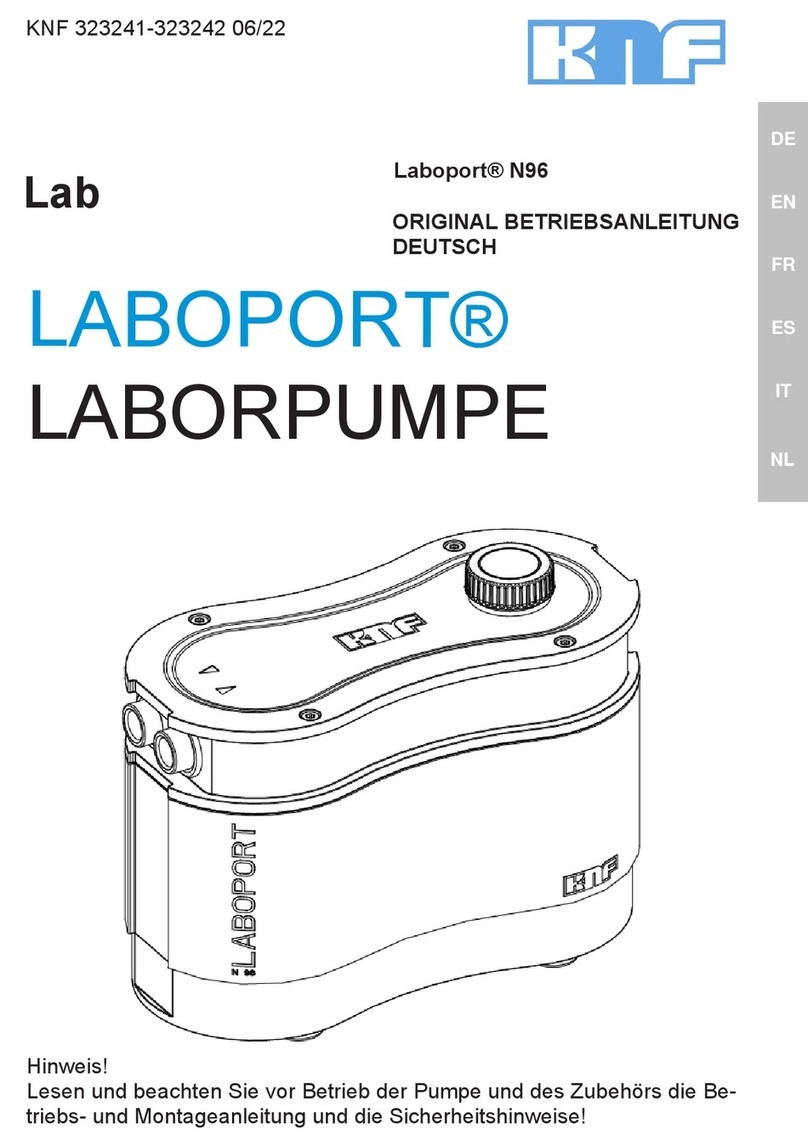
KNF
KNF N96 Translation of original operating instructions

salmson
salmson SUBSON 10 Installation and starting instructions

Nachfolger
Nachfolger HY5 Series quick start guide
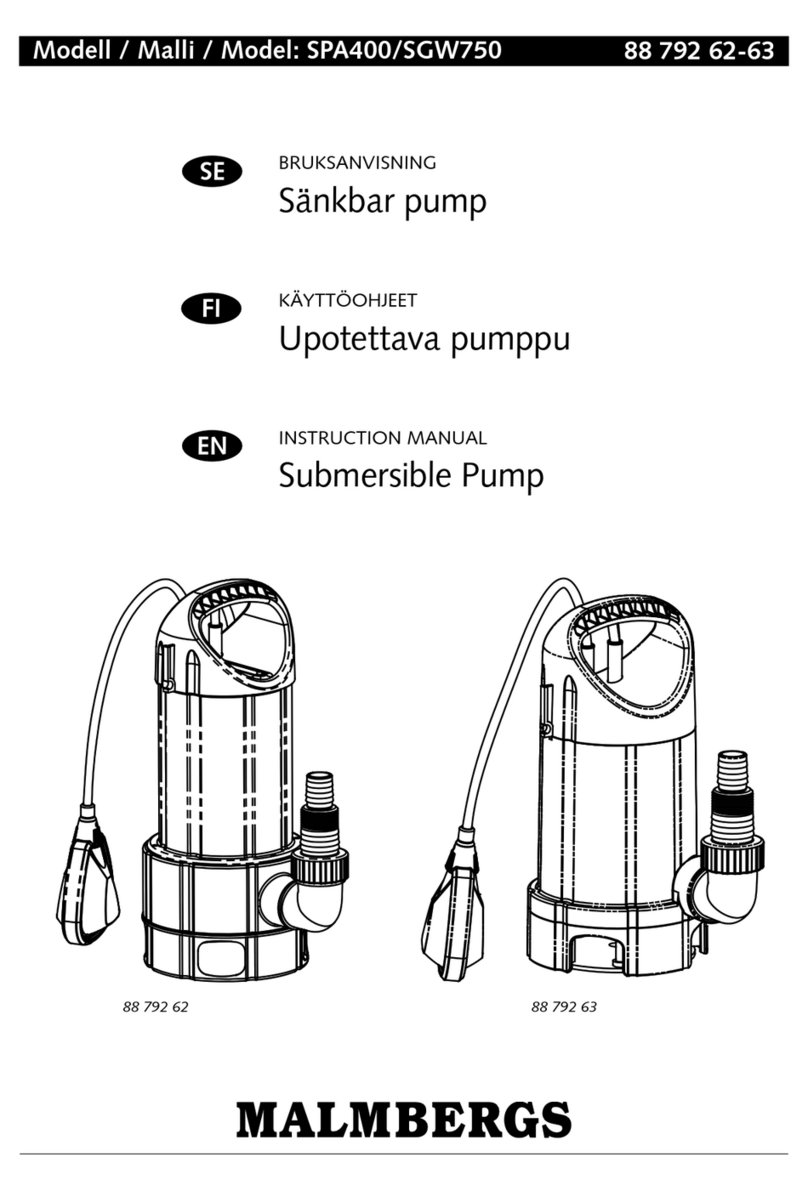
Malmbergs
Malmbergs SPA400 instruction manual
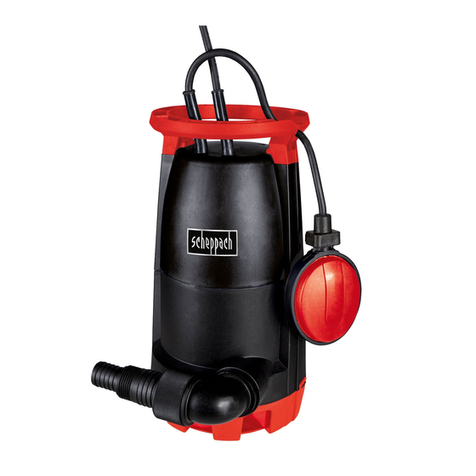
Scheppach
Scheppach SWP750 Translation of original instruction manual

Giant
Giant LP301A-0081 operating instructions

BUSCH
BUSCH R5 Aqua Instruction manual supplement
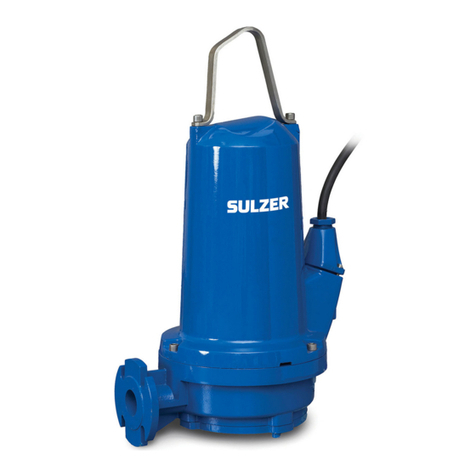
Sulzer
Sulzer ABS Piranha S10/4-60 Installation, operating and maintenance instructions

Roughneck
Roughneck 24925 owner's manual
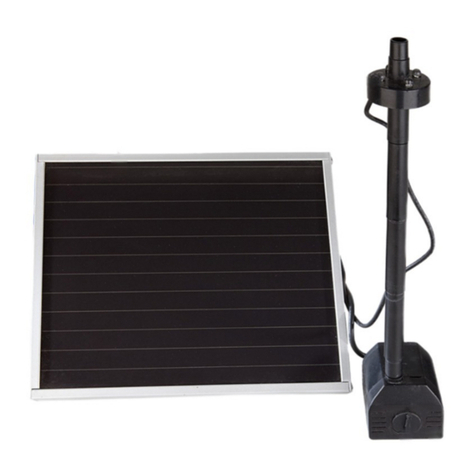
Wetelux
Wetelux 82 06 93 instruction manual
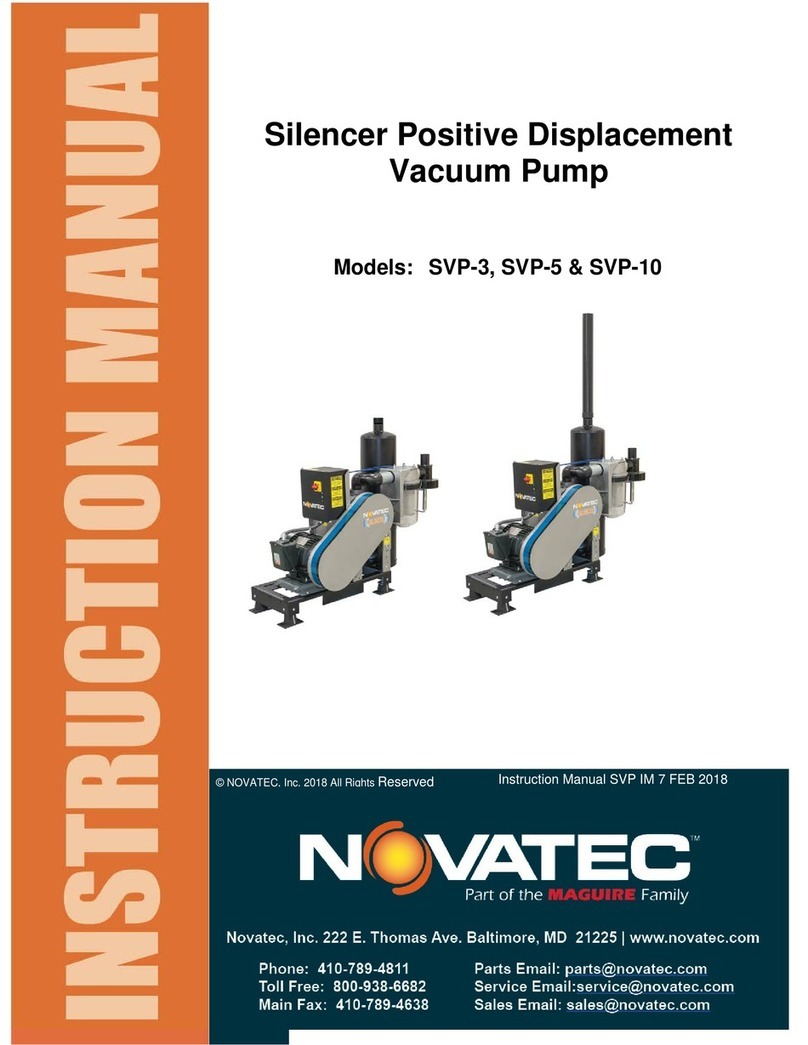
NovaTec
NovaTec SVP-3 instruction manual
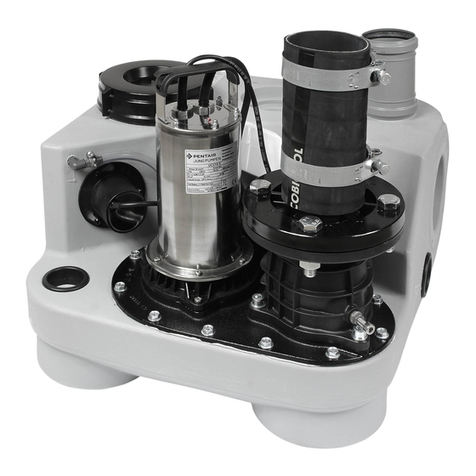
Pentair Jung Pumpen
Pentair Jung Pumpen DRENA-LINE Compli 310 E instruction manual
